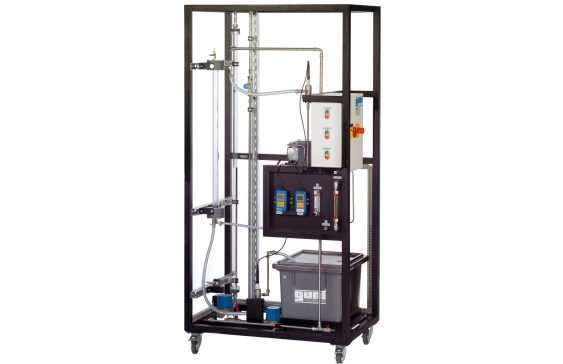CE 405 Falling film absorption

Absorption is used to remove one or more gaseous components from a gas flow using a solvent. Selective absorption is an important industrial process for the treatment of gas mixtures. CE 405 can be used to investigate the basic processes on the water-oxygen-nitrogen system.
A compressor supplies ambient air from below into the absorption column. Water flows down as a thin film at the edge of the absorption column. The air flows upwards centrally in the column. A portion of the air’s oxygen is dissolved in the water film. The air flow exits the column at the top. The water containing the dissolved oxygen leaves the column at the bottom and flows into a tank. A pump supplies the water with the dissolved oxygen to the head of the desorption column.
The desorption column is a simple tube in which the water flows downwards. Nitrogen from a compressed gas cylinder enters at the base of the column. The nitrogen rises to the top in the form of dispersed bubbles in the water. The partial pressure of the oxygen in water is higher than the partial pressure in the gas phase (nitrogen). For this reason, a portion of the oxygen passes over from the water into the gas phase (stripping). This process leads to the water’s absorbing capacity for oxygen increasing.
A pump supplies the solvent regenerated in this way into a channel circulating the upper part of the absorption column. From here the water again flows along the inner wall of the absorption column as a thin falling film and absorbs a portion of the air’s oxygen.
The oxygen concentration and temperature are continuously measured both upstream and downstream of the absorption column. Valves and flow meters make it possible to adjust the air flow rate and solvent flow rate. Transparent materials allow optimal observation of the processes in both columns.
- separation of oxygen from an air flow by absorption in a falling film column
- continuous regeneration of the solvent
- safe operation due to use of water as the solvent and non-hazardous gases
- regeneration of the solvent with nitrogen by stripping
- transparent materials for optimal observation of the processe
Absorption column
- height: 890mm
- inner diameter: 32mm
- material: glass
Desorption column
- height: 1650mm
- inner diameter: 24mm
- material: PMMA
2 pumps
- max. flow rate: 58L/min each
- max. head: 3,7m each
1 compressor
- max. positive pressure: 2bar
- max. flow rate: 23L/min
1 tank
- capacity: approx. 50L
- material: plastic
Measuring ranges
- water flow rate: 40…360mL/min
- air flow rate: 20…360NL/h
- temperature:: 2x 0…50°C
- oxygen concentration: 2x 0…70mg/L
230V, 50Hz, 1 phase
230V, 60Hz, 1 phase
120V, 60Hz, 1 phase
UL/CSA optional
- falling film column for the absorption of oxygen from the ambient air in a solvent (water)
- counterflow process
- 1 compressor for supplying ambient air into the falling film column
- continuous regeneration of the solvent with nitrogen in a desorption column by stripping
- pump for desorption column
- pump for recirculating the solvent to the absorption column
- measurement of oxygen concentration, temperature and flow rate
- 2 hand-held measuring units for measuring the oxygen concentration upstream and downstream of the absorption column
- investigation of the absorption process during the separation of oxygen from an air flow in a falling film column
- balance of the process
- determination of the mass transfer coefficient
